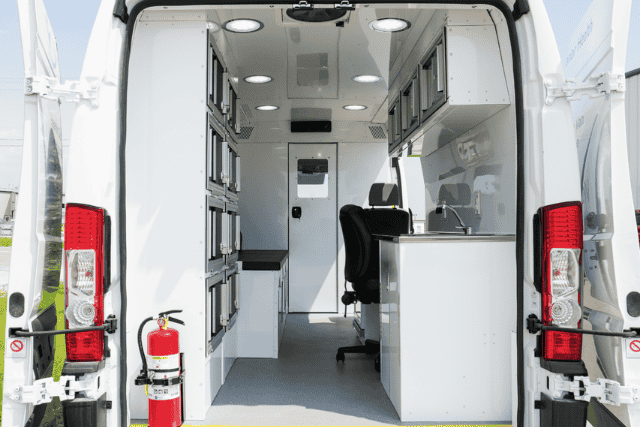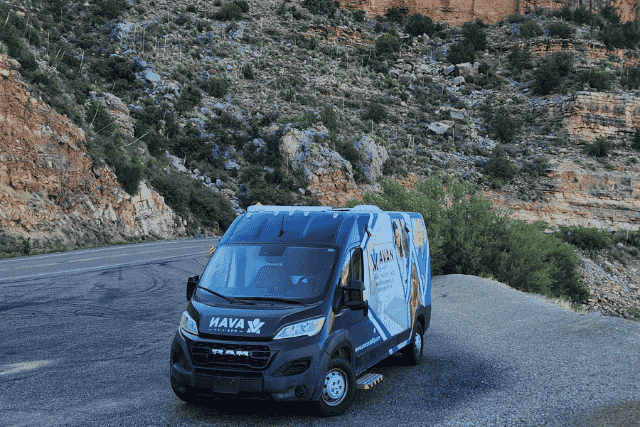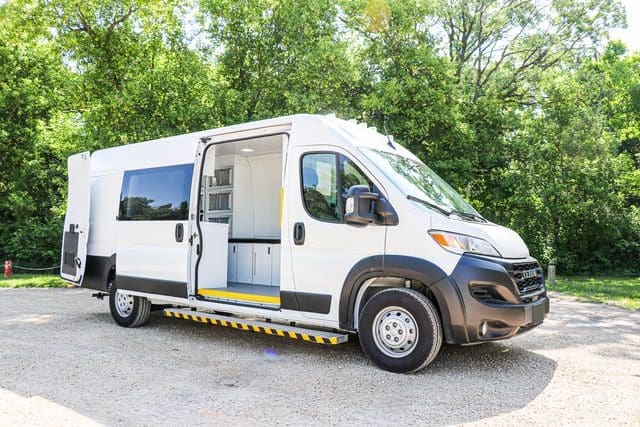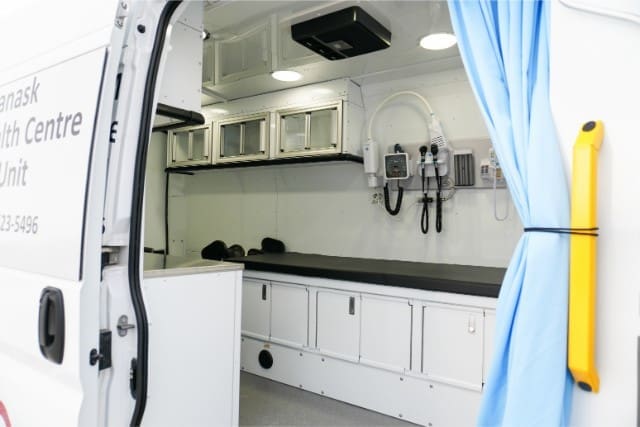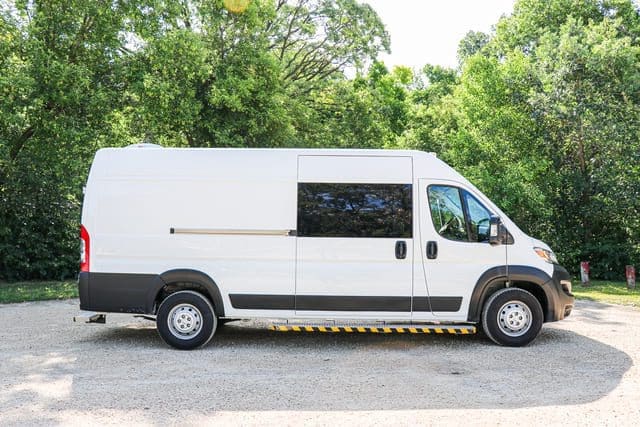In rural parts of Texas, some folks live over 30 miles from the nearest hospital or clinic. That’s like driving an hour round trip just to get a blood pressure check—or worse, waiting until a small issue becomes an emergency.
Maybe you’re a healthcare organization trying to reach more people and know that fixed clinics can’t stretch that far. Mobile clinics in Texas offer a different way—one that meets communities where they are. When care doesn’t come to them, people skip appointments. Conditions get worse. Trust fades. Communities fall behind.
Here’s what’s happening:
- Texas has the highest number of uninsured people in the U.S.
- Over 3 million Texans live in rural areas with limited access to healthcare
- Language and transportation barriers are a daily challenge for diverse populations
That’s the gap mobile clinics can fill.
At AVAN Mobility, we’ve been building mobile medical vehicles for over 10 years, helping organizations like yours—and CalOptima—across the country reduce healthcare barriers and save lives. And while we’re one of many manufacturers, we’re proud to be one you can count on.
In this article, you’ll learn how mobile clinics in Texas help you serve more communities—and how they’re changing healthcare for the better.
What prevents communities in Texas from getting healthcare?
There are several barriers that prevent people living in Texas communities from getting the healthcare they need.
Transportation is a major roadblock in rural Texas
Getting to the doctor shouldn’t feel like planning a cross-country trip. But in many parts of Texas, people don’t have reliable transportation to get to appointments.
Some people rely on a neighbor’s car or public transit—if it’s even available. In smaller communities, arranging a ride might take hours. That delay can mean missing checkups or skipping care altogether.
Millions of Texans live in areas with no or limited transit options.
Now imagine trying to get to a clinic three counties over while dealing with chronic pain or illness. It’s exhausting.
Language barriers keep people from getting proper care
In Texas, around 36% of the population speaks a language other than English at home. That’s a big deal when your healthcare provider can’t understand what you’re saying—or worse, misunderstands it.
For many Spanish-speaking families or recent immigrants, even booking an appointment can feel confusing or intimidating. When language gets in the way, healthcare suffers.
People may stop trying altogether, leading to bigger health issues down the line.
Income and lack of insurance limit choices
Healthcare is expensive—especially if you’re one of the 5.4 million Texans without health insurance.
Low-income families often have to choose between paying bills and seeing a doctor. That means small problems grow into big ones. Preventative care becomes a luxury.
Even in communities with clinics, the cost is a wall people can’t get past.
Healthcare deserts are real in Texas
Many counties in Texas are considered “healthcare deserts.” That means there’s no hospital, no ER, no OB-GYN, and sometimes not even a family doctor.
Some areas, like Presidio County or Kenedy County, have zero hospitals. Source
People in these places are hours from basic care. In emergencies, every minute matters—but geography says otherwise.
Long wait times push people away from care
Even when people can get to a clinic or hospital, they often face long wait times, especially in urban centers with overburdened ERs.
In Texas, the average ER wait time is 3+ hours, and it’s even worse in underserved neighborhoods.
This discourages people from seeking care unless it’s a full-blown emergency. And for someone without a primary care provider, the ER might be their only option. That’s not sustainable, and it doesn’t build trust in the system.
Limited mental health support in many regions
Mental health care is often overlooked, especially in rural and low-income communities. In fact, over 60% of Texas counties don’t have a single psychiatrist.
That means people experiencing anxiety, depression, PTSD, or substance use disorders have nowhere nearby to turn.
When mental health isn’t accessible, it affects everything—family life, school, employment, and physical health too. For some, it becomes a crisis before help is even an option.
How can mobile clinics in Texas overcome these barriers?
We’ve talked about the challenges—now here’s how mobile clinics in Texas step in and make things work for real people, in real places. These clinics don’t wait for patients to show up. They go to them.
Let’s walk through how they make care more accessible.
Care is too far away
Mobile solution:
- Mobile clinics drive directly into rural and remote communities
- Set up in familiar locations like schoolyards, churches, or town halls
- Offer services like blood pressure checks, diabetes screening, and wellness exams
Example: Imagine a nurse practitioner pulling up in a mobile medical clinic outside a small-town library in East Texas. Folks who normally drive two hours to a clinic can now walk down the street and get seen during lunch.
No access to transportation
Mobile solution:
- Mobile medical units meet patients where they are—no bus or ride needed
- Ideal for seniors, people with disabilities, or those living alone
- Cuts down on missed appointments and untreated conditions
Example: A mobile health clinic parks outside a low-income senior housing complex in the Panhandle. Miss Gloria, who uses a walker and hasn’t seen a doctor in months, steps inside with ease and gets her blood sugar checked without having to rely on her niece for a ride.
Language and cultural barriers
Mobile solution:
- Bilingual staff and translators help patients feel safe and understood
- Care is delivered with cultural sensitivity and respect
- Builds stronger relationships between providers and local families
Example: In a Latino-majority neighborhood in San Antonio, a mobile medical clinic in Texas offers well-child visits with Spanish-speaking nurses. Parents feel comfortable asking questions and leave with confidence, not confusion.
Healthcare is too expensive
Mobile solution:
- Services are often free or sliding scale, depending on the funding
- Many clinics partner with local health programs or use Medicaid billing
- Preventive care stops big problems before they start
Example: A single mom in Laredo brings her two kids to a mobile clinic offering free immunizations. She leaves without a bill, and her kids are ready for school—no stress, no surprises.
Mental health support is limited
Mobile solution:
- Clinics can include quiet rooms for private counseling or telehealth access
- Offers a low-pressure space for emotional and psychological care
- Helps people get support earlier, before they reach a crisis
Example: A teenager in a remote West Texas town steps into a mobile clinic parked behind her school. She talks to a mental health nurse for the first time and feels like someone finally sees her. No long wait, no judgment—just help.
ERs are overcrowded
Mobile solution:
- Mobile clinics handle non-emergency needs like infections or chronic care
- Patients skip the ER and get faster treatment in their own neighborhood
- Relieves pressure on overwhelmed hospital staff
Example: A dad brings his daughter with an earache to a mobile clinic in a Dallas parking lot instead of sitting in the ER for hours. They’re in and out in 30 minutes, with meds and peace of mind.
Families can’t juggle multiple appointments
Mobile solution:
- Mobile medical clinics serve kids, parents, and elders all in one place
- Saves families time, gas money, and time off work
- Makes it easier for everyone to stay on top of their health
Example: A mobile medical unit in Texas rolls into a community center in Houston. In one afternoon, grandma gets her blood pressure checked, mom gets prenatal care, and the kids get vaccines. One trip. One clinic. Everyone covered.
Learn more about the impact of mobile clinics in Texas
You came here looking for answers on how to reach more people in your community with healthcare. Maybe you’ve seen people feeling the weight of long distances, limited resources, and growing pressure to do more with less.
Here’s what you’ve uncovered:
- Why mobile clinics in Texas are a smart solution for reaching rural and underserved populations
- How a mobile health clinic in Texas helps solve barriers like transportation, language gaps, and cost
- What it looks like when a mobile medical clinic in Texas brings care directly to communities
- How a mobile medical unit in Texas helps create healthier futures for families, seniors, and children
At AVAN Mobility, we’ve spent over a decade working hand-in-hand with healthcare teams, nonprofits, Tribal health organizations, and public health agencies across the country. Every van we design is built around one mission—removing barriers to healthcare so more people can live longer, healthier lives.
Our team understands more than just the manufacturing processes behind mobile clinics—we understand the organizations and people who use them. Because when it comes down to it, it’s all about people helping people.
If you have questions—or you’re ready to explore what a mobile clinic could look like for your organization—click the button below to talk to a mobility expert.
If now is not the right time to chat, that’s no problem. We’ve got more helpful resources to guide you forward when you’re ready.
Start by checking out our video series on how to start a mobile clinic:
After that, check out our article on six factors to consider when customizing a mobile medical clinic.
FAQ about mobile clinics in Texas
Q: How much does a mobile clinic cost?
A: The cost of a mobile clinic can vary depending on the layout, medical equipment, and level of customization. At AVAN Mobility, most of our mobile clinics range between $170,000 to $290,000. The final price really depends on what you want to offer—basic primary care, dental services, behavioral health, or something more specialized. We’ll work with you to figure out what makes the most sense for your budget and goals.
Q: What kind of medical equipment can be installed in a mobile medical unit in Texas?
A: A mobile clinic can include exam tables, handwashing stations, vaccine fridges, diagnostic tools, blood draw chairs, and even telehealth setups. We help you choose equipment based on your services, whether you’re focused on general care, chronic disease management, or specialty outreach like dental or mental health. Check out our mobile clinic customization article to learn more about that.
Q: Can a mobile clinic run without internet access in rural areas?
A: Yes and no. You can provide in-person care without the internet, but for telehealth, digital records, and billing, you’ll need a connection. Many of our clients use satellite internet to stay connected in rural and remote areas. We design your setup with this in mind so you’re covered even when you’re far off the beaten path.
Q: Can mobile clinics operate in hot Texas summers?
A: Definitely. Our mobile medical units in Texas are built with high-performance air conditioning and insulation designed for extreme heat. We know Texas summers can be brutal, so climate control is a key part of our design. Your staff and patients stay cool and safe no matter where you’re parked.
